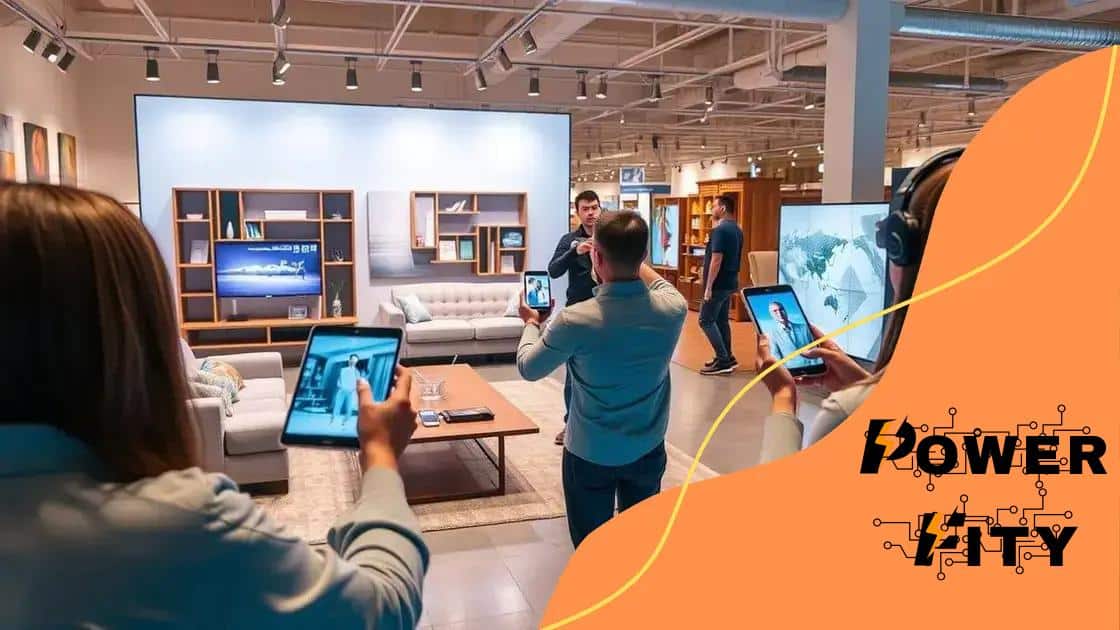Augmented reality in customer service experiences

Augmented reality in customer service enhances user engagement by providing immersive experiences, allowing customers to visualize products in their environment while also presenting challenges like cost, technical limitations, and user education.
Augmented reality in customer service experiences is changing the way we engage with brands. Have you ever wondered how immersive technologies can create memorable interactions? Let’s dive in.
What is augmented reality in customer service?
Augmented reality (AR) in customer service is an innovative approach that enhances the customer experience by blending digital elements with the real world. By using AR technology, companies can provide interactive solutions, making customer interactions more engaging and informative.
This technology allows customers to visualize products or services in their real environment before making a purchase. For instance, imagine trying on new glasses or visualizing furniture in your home through your smartphone. This level of interactivity not only fosters better decision-making but also builds trust between customers and brands.
Key Features of Augmented Reality in Customer Service
The main features of AR in customer service are:
- Visualization: Customers can see how products will look in their environment.
- Interactivity: Users can manipulate virtual elements in a real-world setting.
- Information Overlay: Relevant data is displayed alongside physical products, enhancing understanding.
- Engagement: Interactive experiences capture attention and improve customer satisfaction.
Moreover, companies are utilizing AR for troubleshooting and support. Customers can point their devices at an item and receive live assistance, such as step-by-step guides on how to set up or repair a product. This instant support system significantly reduces wait times and enhances overall customer satisfaction.
Implementing AR requires investment but offers valuable returns in customer loyalty and engagement. As AR technology continues to evolve, its applications in customer service will likely expand, providing even more innovative ways to enhance the shopping experience.
How augmented reality improves customer interactions
Augmented reality (AR) improves customer interactions by creating a more immersive and engaging experience. By integrating virtual elements into the real world, AR allows customers to interact with products in a unique way that traditional methods cannot offer.
For example, a customer looking for new shoes can use an AR app to visualize how different styles would look on their feet without trying them on physically. This technology not only enhances customer satisfaction but also reduces the likelihood of returns.
Enhanced Visualization
One of the key benefits of AR in customer interactions is enhanced visualization. Customers can:
- See products: Visualize items in their own space before purchasing.
- Interact: Touch and manipulate digital content, making it feel more real.
- Compare: Easily compare multiple products in one view.
Furthermore, AR helps to bridge the gap between online and offline shopping experiences. With AR, customers can enjoy the benefits of in-store experiences without having to visit a physical location.
The interactive nature of AR makes it particularly effective in providing product demonstrations. Customers can see how a product works in real time, helping them to better understand its features and benefits.
Building Customer Engagement
AR also plays a significant role in building long-term customer engagement. By providing novel experiences, businesses can create memorable interactions that encourage repeat visits. Customers who enjoy their experience are more likely to share it with others, enhancing organic marketing efforts.
This engagement can lead to increased loyalty and trust towards brands. When customers feel they have a true understanding of a product through AR, they are more likely to proceed with a purchase confidently.
Real-world examples of AR in customer service

Real-world examples of augmented reality in customer service illustrate how various companies are using technology to enhance customer experiences. These examples show the practical application of AR, making interactions more engaging and informative.
Take the furniture industry, for example. Companies like IKEA have developed AR apps that allow customers to visualize how a piece of furniture will look in their home. Users can point their smartphone cameras at a room and place virtual furniture in the space. This interactive experience empowers customers to make better purchasing decisions.
Retail Applications
In the retail sector, the use of AR technology is rapidly growing. Many brands are adopting AR to elevate their in-store experiences. For instance, Sephora’s Virtual Artist app enables customers to try on makeup virtually. By using their smartphone’s camera, customers can see how different products look on their skin without the need for physical samples.
Moreover, brands like Nike are using AR to create personalized shopping experiences. Customers can scan QR codes in-store, which trigger AR content that showcases additional product details, customer reviews, or styling tips.
Travel and Tourism
The travel industry is also leveraging AR. For example, the Marriott hotel chain has implemented AR in their customer service approach. They offer AR experiences that allow guests to see detailed information about nearby attractions simply by pointing their device at them. This adds an exciting layer of information for travelers, enhancing their experience.
Another notable example comes from the automotive industry. Car manufacturers, such as BMW, utilize AR to enhance the car-buying process. Customers can view a 3D model of a car in their driveway and explore its features in a virtual environment. This immersive experience helps potential buyers feel more connected to the product.
Benefits of using augmented reality for businesses
The benefits of using augmented reality for businesses extend far beyond mere novelty. Companies that implement AR can significantly enhance their customer engagement and streamline their operations.
One primary benefit is improved customer satisfaction. By providing interactive and immersive experiences, businesses allow customers to visualize products in their environment, which can lead to higher confidence in purchasing decisions. This direct involvement often translates into increased sales and reduced return rates.
Boosting Brand Awareness
Additionally, AR serves as a powerful marketing tool. Unique AR experiences can differentiate a brand from its competitors, making it more memorable.
- Creating Unique Experiences: Brands that utilize AR can offer exclusive experiences that attract attention.
- Encouraging Social Sharing: Engaging AR content prompts customers to share their experiences on social media, amplifying reach.
- Enhancing Product Understanding: Customers gain a better understanding of how to use products, leading to fewer inquiries and improved satisfaction.
Moreover, AR can help businesses collect valuable data about customer preferences and behaviors. By analyzing how customers interact with AR content, companies can gain insights that inform marketing strategies and product development.
Efficiency and Training
In operational terms, augmented reality can improve internal processes as well. For instance, AR can be utilized for training employees, providing an immersive and practical learning environment. Employees can learn complex tasks by interacting with virtual models that demonstrate procedures and techniques in real time.
This hands-on approach not only enhances retention but also reduces training time, allowing employees to become proficient quickly. As a result, companies can save time and resources.
Challenges and considerations for implementing AR
Implementing augmented reality can bring numerous benefits, but it also comes with challenges that businesses need to consider. Understanding these challenges is crucial for successful adoption.
One major challenge is the high initial cost of AR technology. Developing AR applications often requires significant investment in software and hardware. Companies may need to hire specialists or partner with AR developers, which increases expenses. However, businesses must weigh these costs against the potential return on investment.
Technical Limitations
Another consideration is the technical limitations of current AR technologies. Not all devices support AR applications optimally, which can lead to inconsistent user experiences. Therefore, businesses should ensure that their solutions are compatible with a wide range of devices to reach more customers.
- Device compatibility: Ensuring that AR works on smartphones, tablets, and other devices.
- User experience: AR applications need to provide a seamless and intuitive user experience.
- Internet connectivity: Many AR applications require a stable internet connection, which can limit access for some users.
Moreover, businesses must address privacy and security concerns. AR applications often collect user data to function effectively. This raises issues regarding data protection and user consent. Companies need to be transparent about how they use data and secure the necessary permissions to maintain customer trust.
Educating Users
Educating customers about how to use AR technologies also presents a challenge. Many consumers are not familiar with AR, so businesses must invest in marketing efforts to explain how these experiences work. Offering tutorials or interactive guides can help customers feel more comfortable using AR features.
As the AR landscape evolves, companies must stay updated on the latest trends and advancements. This constant change requires ongoing investment in training and development to keep up with new technologies and consumer expectations. By addressing these challenges proactively, businesses can successfully implement AR solutions that enhance customer experiences.
augmented reality offers exciting possibilities for enhancing customer service experiences. By improving visualization, engagement, and satisfaction, AR can revolutionize how businesses interact with their customers. However, challenges like cost, technical limitations, and user education must be carefully managed. As AR technology continues to evolve, companies that embrace these innovations can gain a competitive edge and build stronger customer relationships.
FAQ – Frequently Asked Questions about Augmented Reality in Customer Service
What is augmented reality (AR)?
Augmented reality is a technology that overlays digital information, like images and sounds, onto the real world, enhancing user experiences.
How can AR improve customer interactions?
AR enhances customer interactions by providing immersive experiences that allow customers to visualize products in their own environment.
What are the main challenges of implementing AR?
Challenges include high initial costs, ensuring technical compatibility, addressing privacy concerns, and educating users on the technology.
What benefits can businesses gain from using AR?
Businesses can benefit from improved engagement, increased customer satisfaction, unique marketing opportunities, and better data collection.





